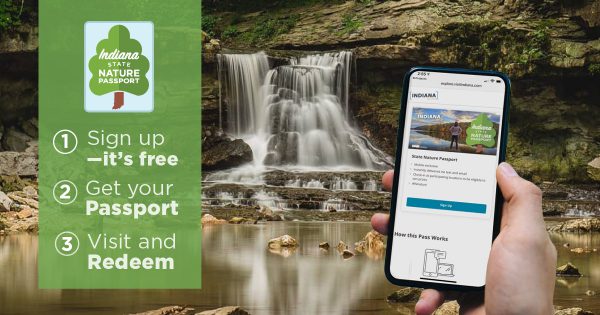No matter where you are in the state of Indiana, you are always less than an hour away from an Indiana State Park. One of Northern Indiana's best is Tippecanoe River State Park, a haven for canoes, kayaks, fishing, and hiking.
With 25 state parks, 8 state reservoirs, 23 fish and wildlife areas, and 15 state forests, we can certainly count ourselves blessed in Indiana with the number of protected outdoor, yet accessible nature areas. During any time of the year, but especially in spring through fall, a visit to one of the state parks, forests, or recreation areas is a great way to connect with nature very close to home. I haven’t visited all of the state parks…yet, but most recently, I took a trip to the Tippecanoe River State Park.
Indiana State Nature Passport
Tippecanoe River State Park is part of the Indiana State Nature Passport! Check-in and explore participating locations throughout the state to earn great prizes! The more you visit, the more you win. This program is 100% free, but property entrance fees apply when you visit. Learn More.
 The Tippecanoe River provides most of the eastern border of the park.
The Tippecanoe River provides most of the eastern border of the park.
Created in 1943, the Tippecanoe River State Park in Pulaski County (Winamac is the closest community) is unique in several ways. The Tippecanoe River borders most of the east side of the park, offering fishing (bass and bluegill are popular catches) and canoeing (bring your own) on a seven-mile stretch.
 The park has some great wetland areas!
The park has some great wetland areas!
The park is also home to an old-growth pine forest, plus almost two miles of preserved wetlands along the river. The park covers 2,761 acres. Along with fishing and canoeing, the park offers horse trails, picnic areas with shelters, and campsites.
The park also offers small cabins with extremely high ratings on Trip Advisor. Check here to see what's currently open and closed at DNR properties.
 Along trail 4, the Oxbow Trail.
Along trail 4, the Oxbow Trail.
Tippecanoe State Park also features 10 different trails, which total 19 miles! The individual trails range from 1.1 miles to 4.7 miles for the more robust hiker (trails range from easy to moderate). We took trail 8, the Bluestem Trail, which goes through the Sand Hill Nature Preserve. We also hiked trail 4, the Oxbow Trail, which goes through the Tippecanoe River Nature Preserve with splendid views of the river.
 Fishing and canoeing are very popular in the park.
Fishing and canoeing are very popular in the park.
As with all state parks, Hoosier residents get in for $7 a car ($9 for non-Hoosiers). For those that visit state parks often, I recommend the $50 annual pass, which gets you into any state park throughout the calendar year ($70 for non-Hoosiers). Camping costs vary depending on the type of camp you prefer and the time of the week you plan to visit, but the prices are all affordable. One word of caution, the river isn’t really best for swimming for safety reasons. For those wanting to cool off with a nice swim, head north to nearby Bass Lake State Beach.
 A 'friend' awaits you in the nature center.
A 'friend' awaits you in the nature center.
Finally, the park also has an interpretive Nature Center and an onsite, seasonal naturalist.
 Wetland area by the nature center.
Wetland area by the nature center.
To the west of the park, across from U.S. 35, the Winamac Fish and Wildlife Area covers 4,880 acres. The area offers a wide assortment of habitats for northern Indiana wildlife “including second growth oak forests, crop and fallow fields, small pine plantations, brushy edges, and small shallow wetlands.” Winamac F&WA offers access for fishing, hunting, and trapping as allowed by state law. Make sure you call before you start your visit (574-946-4422).
As you make your plans for the warmer months, don’t forget to include the state’s great parks and the Tippecanoe River State Park is a great place to start.






